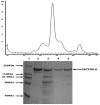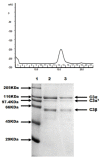The complement system of the goat: haemolytic assays and isolation of major proteins
- PMID: 22734447
- PMCID: PMC3413586
- DOI: 10.1186/1746-6148-8-91
The complement system of the goat: haemolytic assays and isolation of major proteins
Abstract
Background: The aim of the present study was to develop a haemolytic assay for the study of the complement system in dairy goats (Capra aegagrus hircus) and to characterize the major goat complement system proteins.
Results: The commonly used sheep erythrocyte sensitized with rabbit antibodies were not sensitive to lysis by goat serum, but the combination of human red blood cells (RBC) plus rabbit antibodies was the best option found for goat complement assay. A buffer based on HEPES instead of the classical veronal (barbitone) was developed. Three proteins were isolated: factor H, C1q and C3 and these were compared with the corresponding human proteins. A novel affinity chromatography technique was developed for isolation of factor H.
Conclusions: Human RBC plus rabbit antibodies were a suitable option for haemolytic assays. The isolated proteins are similar to the human counterparts.
Figures







Similar articles
-
Sheep Erythrocyte Preparation for Hemolytic Tests Exploring Complement Functional Activities.Methods Mol Biol. 2021;2227:61-67. doi: 10.1007/978-1-0716-1016-9_6. Methods Mol Biol. 2021. PMID: 33847931
-
Demonstration of alternative and classical complement pathway activity in colostrum from buffalo (Bubalus bubalis).Vet Res Commun. 2003 Sep;27(6):445-52. doi: 10.1023/a:1025785506954. Vet Res Commun. 2003. PMID: 14582743
-
Studies on the haemolytic complement of the dromedary camel (Camelus dromedarius). I. Classical pathway haemolytic activity in serum.Vet Immunol Immunopathol. 1995 Jun;46(3-4):337-47. doi: 10.1016/0165-2427(94)05367-2. Vet Immunol Immunopathol. 1995. PMID: 7502492
-
Complement "specificity" and interchangeability: measurement of hemolytic complement levels and use of the complement-fixation test with sera from common domesticated animals.Am J Vet Res. 1977 Oct;38(10):1611-7. Am J Vet Res. 1977. PMID: 337860 Review.
-
Modern determination of complement activation.Semin Thromb Hemost. 2010 Sep;36(6):611-9. doi: 10.1055/s-0030-1262882. Epub 2010 Sep 23. Semin Thromb Hemost. 2010. PMID: 20865637 Review.
Cited by
-
Naturally produced opsonizing antibodies restrict the survival of Mycobacterium tuberculosis in human macrophages by augmenting phagosome maturation.Open Biol. 2015 Dec;5(12):150171. doi: 10.1098/rsob.150171. Open Biol. 2015. PMID: 26674415 Free PMC article.
-
Milk Replacer Supplementation with Docosahexaenoic Acid from Microalgae Does Not Affect Growth and Immune Status in Goat Kids.Animals (Basel). 2020 Jul 20;10(7):1233. doi: 10.3390/ani10071233. Animals (Basel). 2020. PMID: 32698513 Free PMC article.
-
A Uremic Goat Model Created by Subtotal Renal Artery Embolization and Gentamicin.Biology (Basel). 2021 Apr 3;10(4):292. doi: 10.3390/biology10040292. Biology (Basel). 2021. PMID: 33916709 Free PMC article.
-
Lysostaphin Lysibody Leads to Effective Opsonization and Killing of Methicillin-Resistant Staphylococcus aureus in a Murine Model.Antimicrob Agents Chemother. 2018 Sep 24;62(10):e01056-18. doi: 10.1128/AAC.01056-18. Print 2018 Oct. Antimicrob Agents Chemother. 2018. PMID: 30038041 Free PMC article.
-
Comparative Label-Free Liquid Chromatography-Mass Spectrometry Milk Proteomic Profiles Highlight Putative Differences between the Autochthon Teramana and Saanen Goat Breeds.Animals (Basel). 2023 Jul 10;13(14):2263. doi: 10.3390/ani13142263. Animals (Basel). 2023. PMID: 37508040 Free PMC article.
References
-
- Mayilyan KR, Kang YH, Dodds AW, Sim RB. In: Innate Immunity of Plants, Animals and Humans. Heine H, editor. Berlín: Springer-Verlag Berlin Heidelberg; 2008. The complement system in innate immunity; pp. 219–236. 21.
-
- Seelen MA, Roos A, Wieslander J, Mollnes TE, Sjoholm AG, Wurzner R, Loos M, Tedesco F, Sim RB, Garred P, Alexopoulos E, Turner MW, Daha MR. Functional analysis of the classical, alternative, and MBL pathways of the complement system: standardization and validation of a simple ELISA. J Immunol Methods. 2005;296:187–198. doi: 10.1016/j.jim.2004.11.016. - DOI - PubMed
-
- Matsushita M, Endo Y, Fujita T. Cutting edge: complement-activating complex of ficolin and mannose-binding lectin-associated serine protease. J Immunol. 2000;164:2281–2284. - PubMed
Publication types
MeSH terms
Substances
LinkOut - more resources
Full Text Sources
Other Literature Sources
Miscellaneous

